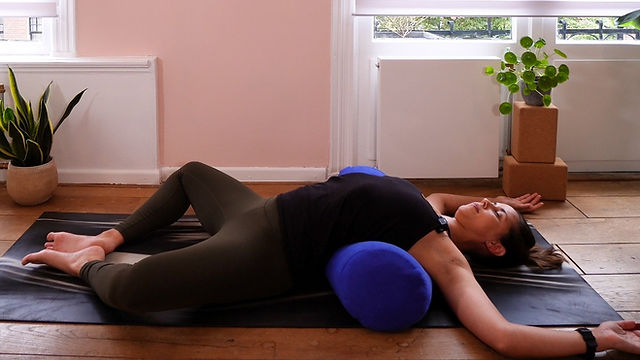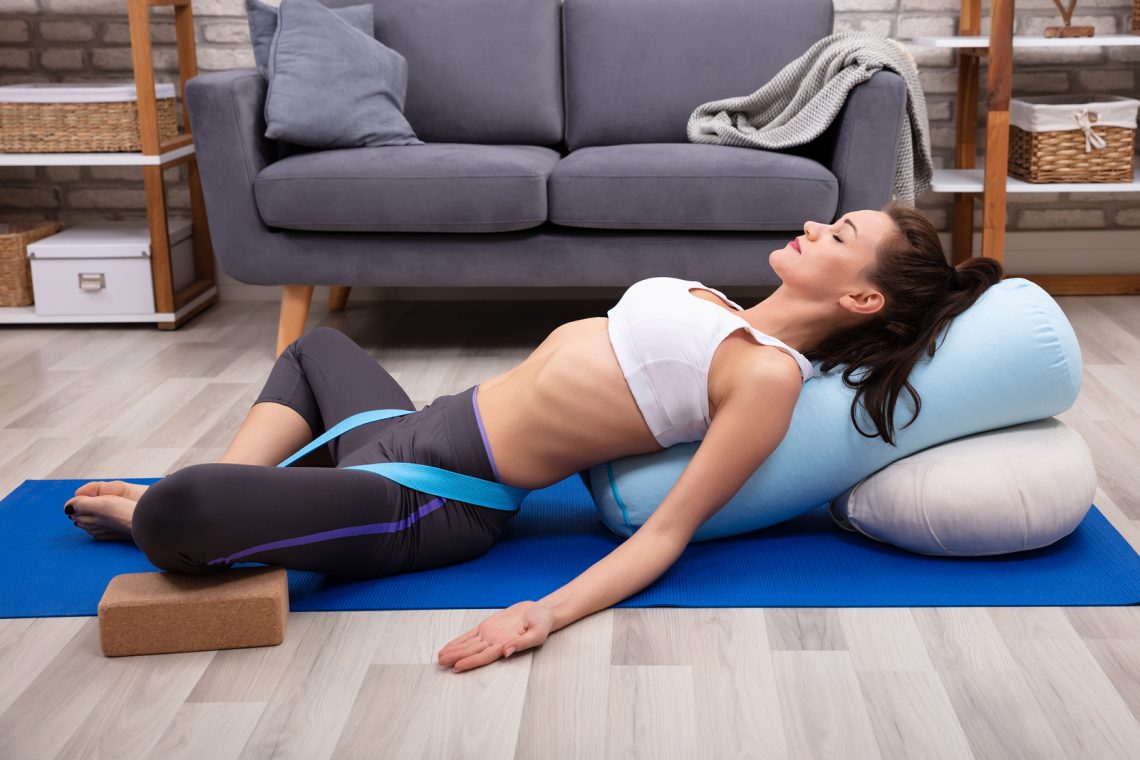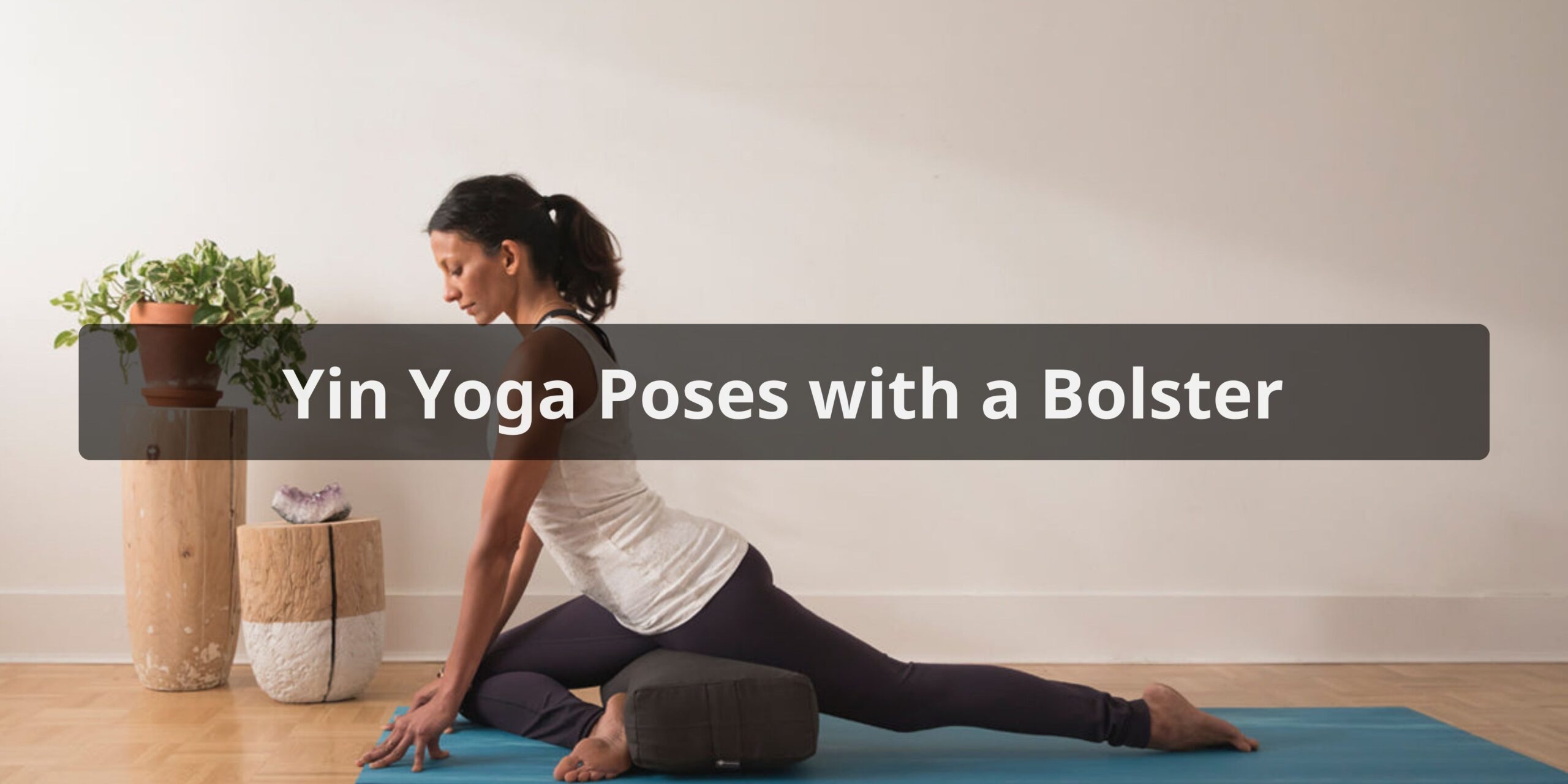Yin yoga incorporates poses that apply moderate stress to the connective tissues—the tendons, fascia, and ligaments—with the aim of increasing circulation and improving flexibility. When a bolster is added to yin poses, it enables the body to relax more deeply into the poses. Bolsters support the body, allowing yin postures to be held for longer periods without strain. This article will explore several yin poses with bolster and the benefits of using props in yin practice.
An Overview of Yin Yoga
Yin yoga complements yang or active yoga practices because it has a slower pace and the postures are held for longer periods, typically 3-5 minutes. The sustained stretches target the deeper connective tissues—the fascia, ligaments, and tendons—that the muscles protect. Whereas yang yoga builds heat and muscular strength, yin yoga is a passive practice that relies on gravity and time to improve joint mobility and flexibility.
In yin yoga, props like bolsters allow the body to sink into a pose gradually. Muscular effort is minimized. The props support the body so it can relax into stressed positions safely. This facilitates the release of fascia and stress while improving circulation in the joints. The bolster enables you to hold challenging yin postures longer, intensifying their benefits.
Why Use a Bolster in Yin Yoga?

There are several advantages to incorporating a bolster into your yin practice:
- Supports the body in passive stretches. Bolsters enable you to completely relax in yin postures by providing support. You can surrender muscular effort and sink deeper into the pose.
- Allows for deeper stretching. With the bolster’s support, you can safely hold yin poses longer without overexerting. This enhances the stretch and stress on connective tissues.
- Prevents injury. Bolsters provide cushioning that protects joints and prevents overstretching. They can support vulnerable areas like the lower back.
- Enhances relaxation. Bolsters provide a comfortable surface to rest on. This invites deeper surrender and calm. Many students fall asleep on their bolsters in yin class!
- Elevates areas of tension. Placing a bolster under a tight area of the body allows gravity to target the tension.Elevating areas like the sacrum releases back tension.
- Brings grounding energy. The soft, yielding surface of the bolster encourages a grounded, heavy sensation. This stimulates the parasympathetic nervous system.
A bolster enables you to hold yin postures safely for extended periods of 3 to 5 minutes. This gives fascia time to release and circulation to increase—providing much-needed nourishment to the joints. The use of props helps facilitate the passive, meditative quality that defines yin yoga.
Yin Yoga Poses Using a Bolster

Here are some key yin yoga poses that can be amplified by incorporating a bolster:
Reclining Butterfly Pose (Supta Baddha Konasana)
- Lie on your back with the bolster lengthwise under your spine and your knees bent, feet on the floor.
- Drop both knees out to the sides in a butterfly shape.
- Stay here with arms resting by your sides, using the breath to sink into any tension in the inner groins and hips.
Supported Fish Pose (Matsyasana)
- Lie back with the bolster under your upper back and head, allowing the head to gently release backwards.
- Stay for a few minutes breathing into the front of the throat. The bolster supports the neck and prevents overarching.
Supported Child’s Pose (Balasana)
- Kneel and lay your torso on the bolster, forehead touching the floor in front.
- Allow the hips to sink back onto the feet and heels. Hold for a few minutes, breathing into the back and hips.
Supported Forward Fold (Uttanasana)
- Stand with feet hip-width apart and fold forward, draping your torso over the bolster.
- With hands on the floor or gripping bolster, relax the head and neck fully, rounding the back.
Supported Caterpillar Pose (Salamba Pindasana)
- Sit on a mat in front of the bolster with legs outstretched.
- Roll gently forward and allow the bolster to support you as the forehead comes to the floor. Relax the arms by your sides.
Supported Saddle Pose (Supta Eka Pada Rajakapotasana)
- Lie over the bolster with it parallel to your spine. Bend your knees and hold the outside of your feet.
- Draw one knee toward your shoulder, keeping the other extended. Switch sides.
These are just some examples of how a bolster can amplify yin postures. Other options are placing it under the sacrum in Straddle Splits or Snake Pose, or using two bolsters for support in Dead Pigeon. Experiment to discover how props allow you to find greater release and comfort in yin poses.
Benefits of Yin Yoga with Props

Here are some of the main benefits of incorporating props like bolsters into your yin yoga practice:
- Enhances joint mobility: By providing support, props allow deeper stretching and range of motion. This increases joint flexibility.
- Reduces risk of overstretching: Bolsters provide a protective buffer against over-exertion in yin poses. This reduces risk of muscle or connective tissue tears.
- Increases circulation: Extended time in poses enhances circulation in connective tissues and joints. This improves mobility.
- Promotes relaxation: Props create total support so muscles can surrender into relaxation. This decreases stress.
- Eases tense areas: Targeted support underneath tight muscles and joints provides gentle traction. This reduces chronic tension.
- Calms the nervous system: The stillness and softness of props activates the parasympathetic nervous system. This lowers anxiety.
- Deepens meditation: By enhancing bodily comfort, props allow the mind to sink into quiet focus. This strengthens mindfulness.
Conclusion
The incorporation of props like bolsters in yin yoga allows practitioners to safely hold poses for longer periods with less effort. Bolsters enable full relaxation into stressed positions, amplifying their benefits. They support vulnerable joints, buffer against overstretching, and provide comfort. Props complement the introspective, meditative nature of yin yoga. Allowing gravity and time to target the deep connective tissues, yin poses with bolsters boost joint health, enhance flexibility, ease chronic tension, and calm the body-mind. With props, yin yoga becomes a profoundly restorative practice.
FAQs About Yin Poses with Bolster
What are Yin Yoga poses with a bolster?
Yin Yoga poses with a bolster involve using a cushion-like prop to support and deepen stretches during practice. These poses include Butterfly Pose, Supported Child’s Pose, and Reclining Bound Angle Pose. Bolsters aid in relaxation and longer holds, enhancing the benefits of passive stretching.
How does using a bolster enhance Yin Yoga practice?
Using a bolster in Yin Yoga enhances practice by providing support, comfort, and stability. It allows practitioners to relax into poses, promoting longer holds, deeper stretches, and improved alignment. Bolsters encourage a sense of surrender, facilitating the release of tension and a deeper mind-body connection.
Can you recommend some Yin Yoga poses that can be done with a bolster?
Certainly, Yin Yoga poses with a bolster include Sphinx Pose for gentle backbends, Supported Fish Pose for chest opening, and Saddle Pose for deep hip stretching. These props make these poses more accessible and comfortable, enabling practitioners to experience their full benefits.
What type of bolster is best for Yin Yoga practice?
A cylindrical or rectangular bolster with a firm yet supportive filling, such as foam or buckwheat, is ideal for Yin Yoga. Look for a bolster that provides enough lift and cushioning to facilitate a comfortable and sustainable stretch in various poses.
Are there any specific guidelines for using a bolster in Yin Yoga?
When using a bolster in Yin Yoga, ensure it supports your body comfortably without causing strain. Place it under body parts needing support, like the spine, hips, or chest. Maintain a gentle, passive stretch and focus on relaxation. Adjust the bolster’s placement as needed to find your optimal comfort and stretch depth.

